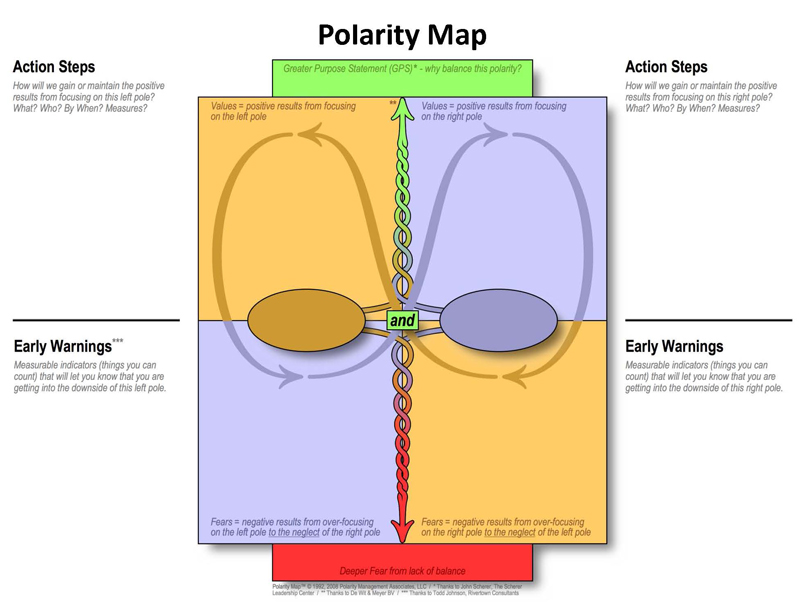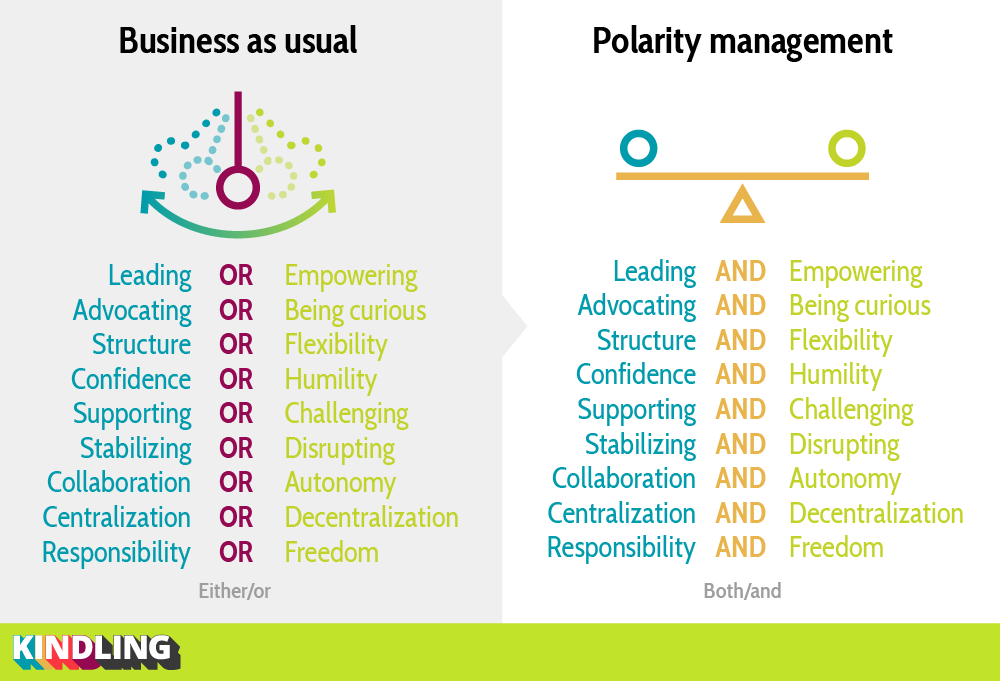Polarity management, the short version
Individuals and organizations tend to swing like a pendulum between opposites (e.g., leading and empowering, structure and flexibility, collaboration and autonomy, etc.) never finding the right balance. Polarity management is the practice of honoring opposing, seemingly conflicting values and finding balance between them.
Polarity management, the longer version
We’ve all seen this classic drawing.

Depending on how you look at it, you can see both a young woman and an old woman. At first glance, we either see the young woman or the old woman. Once someone points it out to us, the second image suddenly comes into view.
Notice: our minds cannot see these two images at once. We have to switch back and forth. Intellectually, we know both are there, but we aren’t naturally equipped to truly take in both at once. We are designed to identify and isolate one pattern, even if many exist.
Seeing the old woman and a young woman in your office
The same is true in the workplace.
Imagine you get a big project and a team is formed to work on it. At first, the project lead gives everyone tasks and they all set out to execute. They are free to make the decisions they need to.
After a few weeks, the team gets together and people start complaining. Their decisions aren’t aligned with one another. There is no cohesion or buy-in among the team. The team begins devolving into secret resentment and disengagement, if not outright bickering.
Finally, the tension reaches a tipping point. Everyone is either livid or disengaged. Everyone agrees they need more coherence. They want to move in lock step as one unit, rather than as disparate parts. So they all agree: from now on, they are going to make decisions by consensus.
After a few weeks of consensus, everyone is at each other’s throats again. Decisions take forever to make. Some people aren’t as inclined to argue, so the more vocal of the group get their way. The most creative, daring ideas are stamped out in favor of more stale, middle-of-the-road approaches.
The team suddenly realizes that making decisions by consensus is overly burdensome. So they now empower everyone to make decisions on their own.
This pattern repeats itself on and on.
The team moves from one pole to another. In one moment, they value collaboration. In the next, they value autonomy. They are constantly moving toward a definitive solution and away from what they deem to be the problem. When that doesn’t work, they reverse their judgment on what the problem is and start moving toward the new solution (which used to be the problem).
There is no answer to wicked problems
This same dynamic is taking place all around us, at all times, on a range of different issues. We go from planning to action to planning to action, from personal growth to acceptance of who we are to personal growth, from centralization to decentralization to centralization, from asking for compassion to demanding accountability back to compassion, from capitalism to socialism to capitalism.
In this dynamic, we never find a good solution. We never get what we need because we believe that there is one clear, simple answer to our problems.
In truth, these problems are unsolvable. They are wicked problems. Neither autonomy nor collaboration is better than the other. Both are essential. Both must be consciously and deliberately balanced with one another from moment to moment.
Some problems are so complex that you have to be highly intelligent and well informed just to be undecided about them.
~ Laurence J. Peter
This balancing process is called polarity management.
Balancing necessary opposites
The most basic message of polarity management is: there is no one “right” answer. There is no simple solution. You may see the old woman, but that doesn’t mean that perspective is “right” or somehow more legitimate. It just means that is what your mind sees.
In many, if not most, cases, if you believe something, the opposite is equally true. You may see extremely clearly how desperately your organization must embrace change and adaptability. But your colleague may see the need for stability just as vividly and be just as “right.”
The deepest wisdom – and your potentially greatest contribution to your organization – is in embracing both those truths at the same time.
Together, these seemingly conflicting truths are polarities. These polarities represent some of the fundamental tensions that come up in our organizations and beyond.

Some common examples of pairs of polarities include:
- Leading AND empowering
- Advocating AND being curious
- Structure AND flexibility
- Confidence AND humility
- Supporting AND challenging
We tend to think that one end of the spectrum must ultimately win out over the other. We choose either to lead or to empower, to support or challenge. But often the most effective way forward is in honoring and embracing both at the same time.
Polarity management, in practice
Polarity Partnerships is a consultancy founded by Leslie DePol and Barry Johnson based out of Sacramento, California. It helps top leaders and organizations to see and address paradox with the intention of creating sustainable growth and effectiveness. Ultimately, Polarity Partnerships’ mission is to promote a higher quality of life for individuals, organizations, and the planet through Polarity Thinking.
It maintains the Polarity Resource Portal (www.polarityresources.com) which provides basic online resources to support anyone with a desire to use Polarity Thinking to build their personal and professional skills.
Next steps
If you’ve accepted that there is no simple answer, that the truest answer lies in the tension and uncertainty, then you’ve already done the hard part. Actually implementing polarity is fairly straight-forward.
To manage polarities all you must do is: 1) identify the two poles or opposites you tend to move between and 2) create a map of the advantages and disadvantages of each of the poles. Your map has four quadrants. The advantages of one pole goes in the top right, while the disadvantage of the pole goes in the bottom right. The advantages of the other pole go in the top left, its disadvantages in the bottom left.
This map should be filled with the symptoms and indicators of when you are experiencing these advantages or disadvantages. For example, if you’re mapping consensus vs. autonomy, you might include “slow decision making” as a disadvantage of consensus.
Once you have your map, you are ready.
In the next step, you commit to continuously sensing which of the advantages and disadvantages you are experiencing in any given movement. If you are experiencing a disadvantage of one pole, you take steps to move toward the other. Once you start experiencing the disadvantages of the opposite pole, you move back toward the other.

This step never ends. It is an ongoing practice.
The difference between polarity management and traditional management is that you don’t ever seek to fully embody one pole; the poles aren’t the goal. Rather, you are constantly moving between the poles in an upward spiral toward the perfect balance between the two.
You put processes in place to avoid the disadvantages and maximize the advantages of both simultaneously. You invite discussion and analysis of where you are in this tension and where you need to be right now. You accept that that answer might be different tomorrow and different yet again the day after.
Polarity management for humanity itself
Polarity management has become prominent as an organizational management tool. But polarity management is equally applicable and valuable in many other spheres of life – for individuals, for families, for communities, and for countries. Perhaps most importantly, humanity itself can learn from polarity management.
As just one example, more and more of us are calling for us to look beyond skin color and cultural norms, to see the humanity that binds us. This is absolutely essential for our survival and prosperity.
At the same time, it’s equally true that many of us want to protect tradition and our own cultural identities. We fear that in focusing only on our common humanity, we will lose the qualities that made our communities unique and gave us our sense of identity.
What if we all accepted that both are equally true and equally necessary? What if instead of arguing which is more important, we began a discussion of how to balance the two?
When we allow ourselves to see the truth in opposites, we reveal a world of possibility and beauty.
That is polarity management.
Recommended reading
Polarity Management: Identifying and Managing Unsolvable Problems
by Barry Johnson
Polarity Management presents a unique model and set of principles that will challenge you to look at situations in new ways. Also included are exercises to strengthen your skills, and case studies to help you begin applying the model to your own unsolvable problems.
More on polarity management
- Problem Solving Vs. Polarity Management Slideshare by SAPICS
- Polarity Management overview by Barry Johnson
- Are You Facing A Problem or a Polarity? by Center for Creative Leadership


